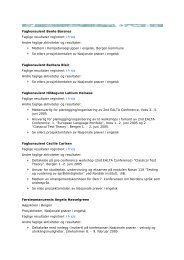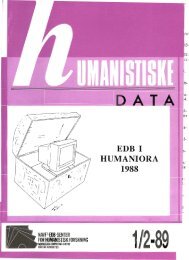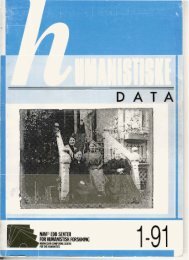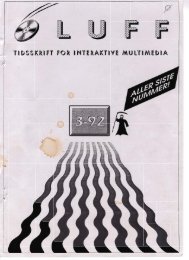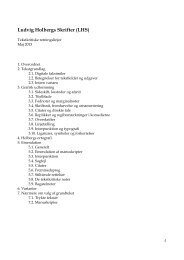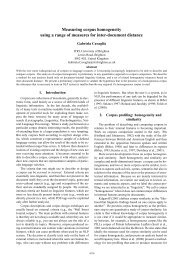1991:2 - Universitetet i Bergen
1991:2 - Universitetet i Bergen
1991:2 - Universitetet i Bergen
You also want an ePaper? Increase the reach of your titles
YUMPU automatically turns print PDFs into web optimized ePapers that Google loves.
technology for various purposes. Onc applicatian concerns the museum's<br />
collections of objccts. 1 million objecu wcre registercd in grotocoIs or<br />
on cards, and thc registered objects wcre safely skored away in depok:<br />
in pracrice inarcessible to borh scsearch~rs and museum personneI. By<br />
updating thc catnlogues on computer, and storing pictures of the objects<br />
on vidco disks. khe museum has created an effective organisational tool,<br />
as wc11 as a good source of information for sesearch.<br />
As an exampIe of a multimedia information system. the author points<br />
to the National Museum's product on the Danish Liberation SLsuggIe<br />
1940-45. which consists of 11,000 phatographs and nine video sequences<br />
stored on a video disk, and a computer control system to guide the<br />
vicwcr to exactly the material of choice. This video disk has bccn on<br />
the market for more han a year, and is sold to a number of schools<br />
in Scandinavia and ta rcsertrch institutions in mmy parts of the world.<br />
People have objected to sorne of the iniormatien presetned, and actually<br />
corrected the "official" vcrsions of the evenrs.<br />
Thc RoyJ Library in Copenhagcn is planning a national picture<br />
database in cooperation with Danmarks Radio: the purpose is lo register<br />
and make accessibIc large colIections of pictures - about 10,000,000<br />
ilerns - which at present are diBicult to access: they are found in just<br />
one Iocadon, Slolsholmen, and can be viewed only during opening<br />
hours and under ~hs auspices of a museum consultant. An average of<br />
60,000 such visitors are guided through relevant collections every year,<br />
which naturally drawc heavily on the resources of the museum. Besidcs,<br />
searching, in this case rneans Icafing through the miginals, provided<br />
they are available and registered.<br />
In this situation a database of digitized pictures stored on same<br />
opticaI storage medium will faciIitate easy access, quick and ellicient<br />
searches - and geography is no hindrance.<br />
The thitd case is kaken from Telccorn Denmark in Tåstrup. which is<br />
developing a database OF historical picturcs showing the developmcnt<br />
of teIe-communications in Denmark.<br />
These cases share cornmon concems for conservation, disaeminntion,<br />
technology and ecanomy.<br />
New technology rnay definitdy reduce the wear and kar on the<br />
original pholographic material through the creation of compupter registess<br />
with digjlized copies. Some kind of permanent siorage for rhe original<br />
material will sti11 have to be round.<br />
Dissemination is very weI1 catered for by the new technology: it<br />
may givc the museum personne1 a new, complete overview over the<br />
colIecLions, and visitors rnay freely search the entire picture base.<br />
Technology: Ar present data bases of high-soIution data bases are<br />
very expensive. The best solutions seem to be centtal information data<br />
HUMANISIISKE DATA 2:91 IS5




